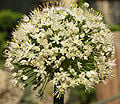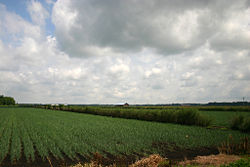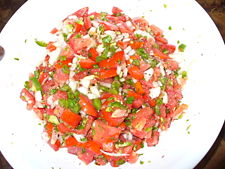Onion
| Onion | ||||||||||||||
|---|---|---|---|---|---|---|---|---|---|---|---|---|---|---|
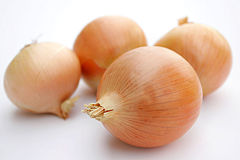 Onions
| ||||||||||||||
| Scientific classification | ||||||||||||||
| ||||||||||||||
| Allium cepa L. |
Onion is the common name for the herbaceous plant Allium cepa, characterized by a edible, rounded bulb composed of concentric, fleshy, tightly packed food-storage leaves. Onion is also the name of this edible bulb that is known for its pungent oil that departs a strong taste. Closely related plants of the same genus include chives (Allium schoenoprasum), garlic (A. sativum and A. scordoprasum), and leeks (A. porrum). Other plants in the genus Allium also have the common name of onion, such as the Welsh onion (A. fistulosum), but when used without qualifiers, onion usually refers to Allium cepa. It is also known as the garden onion.
Description
Onions are variously placed in the flowering plant family Alliaceae or Liliales. Alliaceae is a family of herbaceous plants are monocots, part of order Asparagales. The family has been widely but not universally recognized; in the past, the plants involved were often treated as belonging to the family Liliaceae, and still are by some botanists. The Liliaceae, or the lily family, is a family of monocots in the order Liliales. Plants in this family have linear leaves, mostly with parallel veins, and flower parts in threes. The lily family was formerly a paraphyletic "catch-all" group that included a great number of genera that are now included in other families, including those now placed in Alliaceae.
Allium cepa is known only in cultivation; it is no longer found in the wild. However, related wild species occur in Central Asia. The most closely-related species include Allium vavilovii Popov & Vved. and Allium asarense R.M. Fritsch & Matin from Iran (Grubben and Denton 2004). However Zohary and Hopf (2000) warn that "there are doubts whether the vavilovii collections tested represent genuine wild material or only feral derivatives of the crop."
Allim cepa is believed to be of Asiatic origin. It is a hardy garden vegetable. The underground leaf bases, used in food storage, swell and from a tightly packed, concentric, fleshy bulb that is rich in carbohydrates and a sulfur-rich volatile oil. They are grown mainly for this edible bulb, which has a pungent odor and taste, but the above-ground leaves also are eaten.
Numerous varieties have been developed, with a diversity of flavors (mild or pungent), colors (white, yellow, brown, red), sizes, and shapes. Two main classifications are green onions (or spring onions, those harvested while immature) and dry onions (mature onions with a juicy flesh covered with dry, papery skin (Herbst 2001). Green onions are also known as scallions, which is a term associated with various members of the genus Allium that lack a fully-developed bulb. (The term scallion and green onion particularly is used to refer to the Welsh onion, Allium fistulosum, which is said not to produce dry bulbs.)
Along with garlics (Allium sativum), chives (A. schoenoprasum), and leeks (A. porrum), shallots are a close relative of onions. Shallot, as the word is commonly used, actually refers to two different Allium species of plant. The French grey shallot or griselle, which has been considered to be the "true shallot" by many, is Allium oschaninii, a species that grows wild from Central to Southwest Asia. Other varieties of shallot include Allium cepa var. aggregatum or multiplier onions, which are considered by some as a variety of the onion, but which others list as the separate species A. ascalonicum.
Propagation and varieties
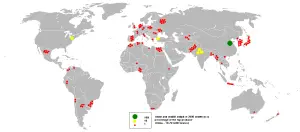
Onions may be grown from seed or, most commonly, from sets. Onion sets are produced by sowing seed very thickly one year, resulting in stunted plants that produce very small bulbs. These bulbs are very easy to set out and grow into mature bulbs the following year, but they have the reputation of producing a less durable bulb than onions grown directly from seed and thinned.
Either planting method may be used to produce spring onions or green onions.
- Bulb onion - Grown from seed (or onion sets), bulb onions range from the pungent varieties used for dried soups and onion powder to the mild and hearty sweet onions, such as the Vidalia from Georgia or Walla Walla from Washington that can be sliced and eaten on a sandwich instead of meat.
- Multiplier onions - Raised from bulbs which produce multiple shoots, each of which forms a bulb.
- Potato onion
- Tree onion or Egyptian onion - Produce bulblets in the flower head; a hybrid of Allium cepas.
Production trends
| Top Ten Onions Producers—2005 (1000 tonnes) | |
|---|---|
| 19,793 | |
| 5,500 | |
| 3,346 | |
| 2,220 | |
| 1,764 | |
| 1,758 | |
| 1,750 | |
| 1,637 | |
| 1,302 | |
| 1,149 | |
| World Total | 64,101 |
| Source: UN Food & Agriculture Organization (FAO)[1] | |
Uses
It is thought that bulbs from the onion family have been used as a food source for millennia. In Caananite Bronze Age settlements, traces of onion remains were found alongside fig and date stones dating back to 5000 B.C.E. However, it is not clear if these were cultivated onions. Archaeological and literary evidence suggests cultivation probably took place around two thousand years later in ancient Egypt, at the same time that leeks and garlic were cultivated. Workers who built the Egyptian pyramids may have been fed radishes and onions (SelfSufficientish 2007).
The onion is easily propagated, transported and stored. Egyptians worshipped it, believing that its spherical shape and concentric rings symbolized eternal life. Onions were even used in Egyptian burials as evidenced by onion traces being found in the eye sockets of Ramesses IV. They believed that if buried with the dead, the strong scent of onions would bring breath back to the dead.
In ancient Greece, athletes ate large quantities of onion because it was believed that it would lighten the balance of blood. Roman gladiators were rubbed down with onion to firm up their muscles. In the Middle Ages, onions were such an important food that people would pay for their rent with onions and even give them as gifts. Doctors were known to prescribe onions to relieve headaches, snakebite, and hair loss. The onion was introduced to North America by Christopher Columbus on his 1492 expedition to Haiti. Onions were also prescribed by doctors in the early 1500s to help with infertility in women, and even dogs and cattle and many other household pets.
Today, onions are available in fresh, frozen, canned, pickled, and dehydrated forms. Onions can be used, usually chopped or sliced, in almost every type of food, including cooked foods and fresh salads, and as a spicy garnish. They are rarely eaten on their own but usually act as accompaniment to the main course. Depending on the variety, an onion can be sharp, spicy, and pungent or mild and sweet.
Onions pickled in vinegar are eaten as a snack. These are often served as a side serving in fish and chip shops throughout the United Kingdom. Onions are a staple food in India, and are therefore fundamental to Indian cooking. They are commonly used as a base for curries, or made into a paste and eaten as a main course or as a side dish.
Tissue from onions is frequently used in science education to demonstrate microscope usage, because they have particularly large cells which are readily observed even at low magnifications.
Medicinal properties and health benefits
| Raw Onions Nutritional value per 100 g | |||||||||||||||||||||||||||||||||||||||||||||||
|---|---|---|---|---|---|---|---|---|---|---|---|---|---|---|---|---|---|---|---|---|---|---|---|---|---|---|---|---|---|---|---|---|---|---|---|---|---|---|---|---|---|---|---|---|---|---|---|
| Energy 40 kcal 170 kJ | |||||||||||||||||||||||||||||||||||||||||||||||
| |||||||||||||||||||||||||||||||||||||||||||||||
| Percentages are relative to US recommendations for adults. Source: USDA Nutrient database | |||||||||||||||||||||||||||||||||||||||||||||||
While onions are not particularly high in most nutrients, they do contain anti-inflammatory, anti-cholesterol, anti-cancer, and antioxidant components, such as quercetin (GMF 2007). They also are rich in vitamin C and in chromium, a trace mineral tied to insulin response (GMF 2007). Onions, like garlic, is rich in sulfur-containing compounds that yield its pungent odor and taste and is responsible for many of its health effects (GMF 2007).
Evidence suggests that onions may be effective against the common cold, heart disease, diabetes, osteoporosis, and other diseases.
Onion consumption has been found to be inversely proportional to glucose levels in oral or intravenous glucose tolerance tests—which is suggested to trace to the allyl propyl disulfide in onions, which lowers blood sugar levels by increasing availability of free insulin (GMF 2007). Chromium is also considered to help cells respond appropriately to insulin, with clinical trials showing that chromium can improve glucose tolerance, lower insulin levels, decrease fasting blood glucose levels, and decrease total cholesterol levels (GMF 2007). Consumption of onions has been traced to lower high cholesterol levels and high blood pressure—like due to chromium, sulfur compounds, and vitamin B6 (GMF 2007).
Onions are a major source of flavonoids and phytochemicals, which are shown to have protective qualities against both cardiovascular disease and cancer (GMF 2007). Onions may be valuable for preventing excessive bone loss in women at increased risk for osteoporosis as they go through menopause, as it has a chemical that inhibits the activity of osteoclasts (the cells that break down bone) (GMF 2007).
In many parts of the world, onions are used to heal blisters and boils. In homeopathy, Allium cepa is used for rhinorrhea and hay fever (Morrison 1993). Research suggests that quercetin, found in onions, reduces the size and number of precancerous lesions in the human intestinal tract (GMF 2007).
Onions and eye irritation
As onions are sliced, cells are broken, allowing enzymes called alliinases to break down sulfides and generate sulfenic acids (amino acid sulfoxides). Sulphenic acids are unstable and decompose into a volatile gas called syn-propanethial-S-oxide. The gas diffuses through the air and eventually reaches the eye, where it reacts with the water to form a diluted solution of sulfuric acid. This acid irritates the nerve endings in the eye, making them sting. Tear glands produce tears to dilute and flush out the irritant (Scott 1999).
Supplying ample water to the reaction prevents the gas from reaching the eyes. Eye irritation can, therefore, be avoided by cutting onions under running water or submerged in a basin of water. Rinsing the onion and leaving it wet while chopping may also be effective. Another way to avoid irritation is by not cutting off the root of the onion, or by doing it last, as the root of the onion has a higher concentration of enzymes (NOA). Chilling or freezing onions prevents the enzymes from activating, limiting the amount of gas generated. Using a sharp blade to chop onions will limit the cell damage and the release of enzymes that drive the irritation response. Having a fire, such as a candle or a burner, will help as the heat and flames will draw in the onion gas, burn it, and then send it up with the rest of the flame exhaust. In the heat, the chemical changes such that it no longer irritates the eyes.
The volume of sulphenic acids released, and the irritation effect, differs among Allium species.
ReferencesISBN links support NWE through referral fees
Michael F. Fay and Mark W. Chase. 1996. Resurrection of Themidaceae for the Brodiaea alliance, and Recircumscription of Alliaceae, Amaryllidaceae and Agapanthoideae. Taxon 45: 441-451 (abstract)
.[1]
< ref>National Onion Association (NOA). n.d. [http://www.onions-usa.org/about/faq.asp#cooking About Onions: Frequently Asked Questions]. Onions-USA.org. Retrieved November 11, 2007.</ref>
External links
- PROTAbase on Allium cepa. Retrieved November 11, 2007.
- Fry, Steve. The Secret to Cutting Onions Without Crying. Retrieved November 11, 2007.
Credits
New World Encyclopedia writers and editors rewrote and completed the Wikipedia article in accordance with New World Encyclopedia standards. This article abides by terms of the Creative Commons CC-by-sa 3.0 License (CC-by-sa), which may be used and disseminated with proper attribution. Credit is due under the terms of this license that can reference both the New World Encyclopedia contributors and the selfless volunteer contributors of the Wikimedia Foundation. To cite this article click here for a list of acceptable citing formats.The history of earlier contributions by wikipedians is accessible to researchers here:
The history of this article since it was imported to New World Encyclopedia:
Note: Some restrictions may apply to use of individual images which are separately licensed.
- ↑ Morrison, Roger. 1993. Desktop guide to keynotes and confirmatory symptoms. Grass Valley, CA: Hahnemann Clinic Publishing. ISBN 0-9635368-0-X.
- ↑ The George Mateljan Foundation (GMF). Onions. World's Healthiest Foods. Retrieved November 11, 2007.
- ↑ Onions Allium cepa. selfsufficientish.com. Retrieved November 11, 2007.
- ↑ Scott, Thomas. What is the chemical process that causes my eyes to tear when I peel an onion? Scientific American. October 1, 1999. Retrieved November 11, 2007.
- ↑ Zohary, Daniel and Maria Hopf. 2000. Domestication of plants in the Old World. Oxford, UK: Oxford University Press. ISBN 0198503571.
- ↑ Grubben, G.J.H. & O.A. Denton. 2004. Plant Resources of Tropical Africa 2, Vegetables. PROTA Foundation. Leiden, NL: Backhuys. ISBN 9057821486.


